Page 119 of 358
Ventilation Tips
Keep the hood and front air inlet free
of ice, snow, or any other obstruction
(such as leaves). The heater and
defroster will work far better, reducing
the chance of fogging the inside of
your windows.
When you enter a vehicle
in cold
weather, turn the fan control knob to
the right for
a few moments before
driving off. This helps clear the intake
ducts of snow and moisture, and
reduces the chance of fogging the
inside
of your windows.
D Keep the air path under the front seats
clear of objects. This helps air to
circulate throughout your vehicle.
Audio Systems
Your Delco@ audio system has been
designed to operate easily and give years
of listening pleasure. But you will get the
most enjoyment out of
it if you acquaint
yourself
with it first. Find out what your
Delco@ system can do and how to operate
all its controls, to be sure you’re getting
the most out of the advanced engineering
that went into
it.
ProCarManuals.com
Page 177 of 358

Run your engine only as long as you
must. This saves fuel. When you
run the
engine, make
it go a little faster than just
idle. That is, push the accelerator slightly.
This uses less fuel for the heat that you
get and
it keeps the battery charged. You
will need a well-charged battery to restart
the vehicle, and possibly for signaling
later on
with your headlights. Let the
heater
run for awhile.
Then. shut the engine off and close the
window almost all the way to preserve the
heat. Start the engine again and repeat this
only when you feel really uncomfortable
from the cold.
But do it as little as
possible. Preserve the fuel as long as you
can.
To help keep warm. you can get out
3f the vehicle and do some fairly vigorous
zxercises every half hour or
so until help
Zomes.
If You're Stuck in Deep Snow
This manual explains how to get the
vehicle
out of deep snow without
damaging it. See "Rocking Your Vehicle"
in the Index.
Towing a Trailer
you can lose control when you pull
a trailer. For example, if the trailer is
too heavy, the brakes may not work
well - or even at all. You and your
passengers could be seriously
injured. Pull a trailer only if you
have followed all the steps in this
section.
ProCarManuals.com
Page 199 of 358
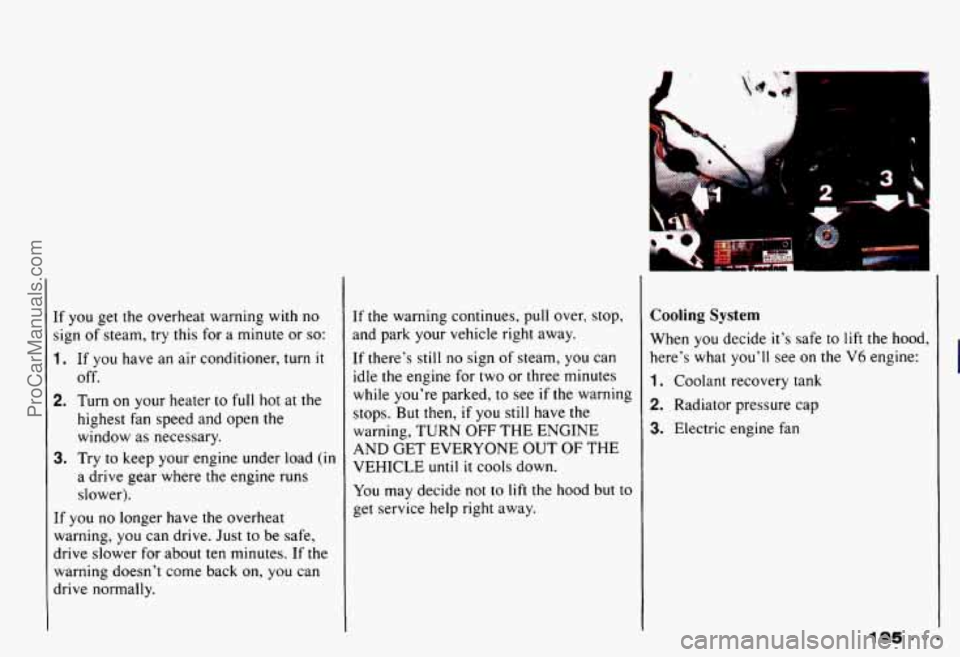
If you get the overheat warning with no
sign of steam,
try this for a minute or so:
1. If you have an air conditioner, turn it
2. Turn on your heater to full hot at the
off.
highest fan speed and open
the
window
as necessary.
3. Try to keep your engine under load (in
a drive gear where the engine runs
slower).
If you no longer have the overheat
warning, you can drive. Just
to be safe,
drive slower for about
ten minutes. If the
warning doesn’t come back on,
you can
drive normally. If
the warning
continues, pull over, stop,
and park your vehicle right away.
If there’s
still no sign of steam, you can
idle
the engine for two or three minutes
while you’re parked, to see
if the warning
stops.
But then, if you still have the
warning, TURN
OFF THE ENGINE
AND GET EVERYONE OUT
OF THE
VEHICLE
until it cools down.
You may decide not to
lift the hood but to
get service help right away.
Cooling System
When you decide it’s safe to lift the hood,
here’s what you’ll see on the V6 engine:
1.
2.
3.
Coolant recovery tank
Radiator pressure cap
Electric engine
fan
ProCarManuals.com
Page 200 of 358
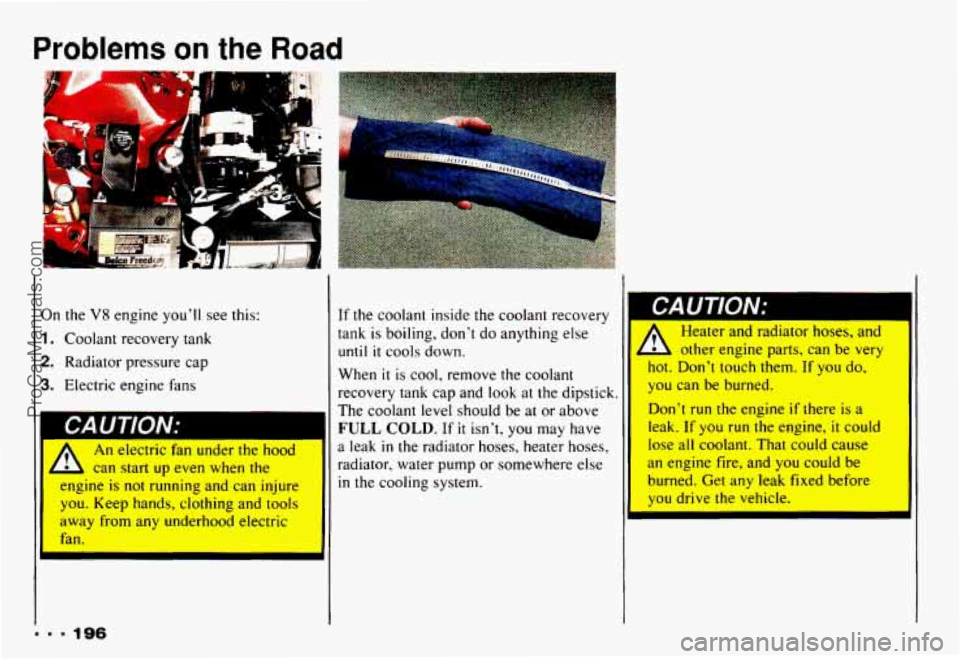
Problems on the Road
I. -
.. .
On the V8 engine you’ll see this:
1. Coolant recovery tank
2. Radiator pressure cap
3. Electric engine fans
An electric fan under the hood
L can start up even when the
engine
is not running and can injure
you. Keep hands, clbthing and tools
away from any underhood electric
fan.
... 196
I I
If the coolant inside the coolant recovery
tank
is boiling, don’t do anything else
until it cools down.
When
it is cool, remove the coolant
recovery tank cap and
look at the dipstick. I I
The coolant level should be at or above
FULL COLD. If it isn’t, you may have
a leak
in the radiator hoses, heater hoses,
radiator, water pump or somewhere else
in the cooling system. II
A Heater and radiator hoses, and
L other engine parts, can be very
hot. Don’t touch them.
If you do,
you can be burned. ~
Don’t run the engine if there is a
leak. If
you run the engine, it could
lose
all coolant. That could cause
an engine fire, and you could be
burned. Get any leak fixed before
you drive the vehicle.
ProCarManuals.com
Page 202 of 358
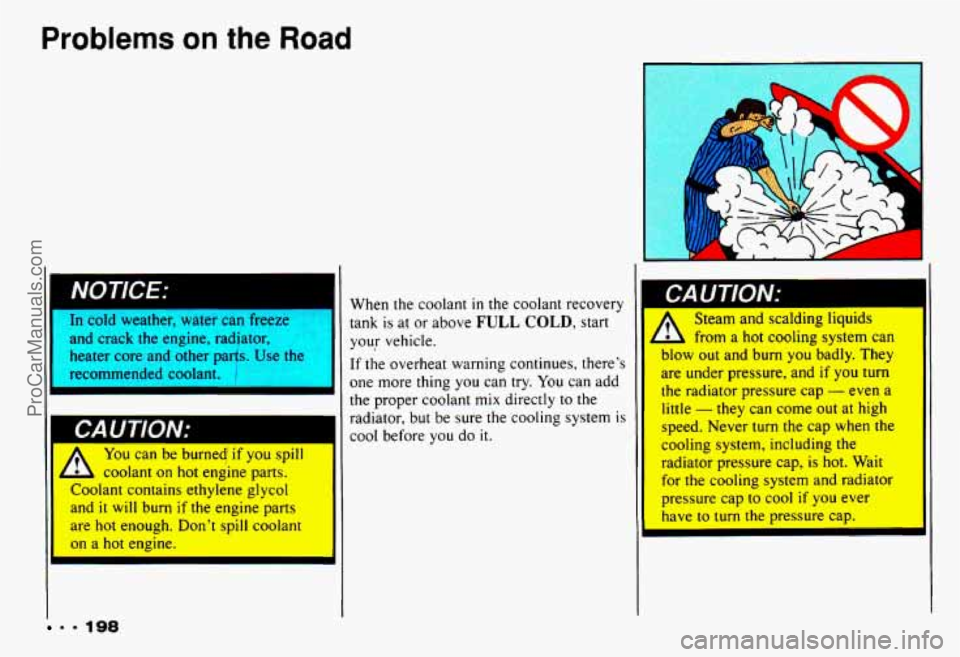
Problems on the Road
and crack the engine, radiator,
heater core and other parts.
Use the
recommended coolant.
‘I
A You can be burne4 if you spill
- L coolant on hot engine parts.
Coolant contains ethylene glycol
and
it will burn if the engine parts
are hot enough. Don’t spill coolant
on
a hot engine.
9.198
When the coolant in the coolant recovery
tank is at or above
FULL COLD, start
your vehicle.
If the overheat warning continues, there’s
one more thing you can
try. You can add
the proper coolant
mix directly to the
radiator, but be sure the cooling system is
cool before you do
it.
I
CAUTION:
Steam and scalding liquids
from a hot cooling system can
blow out and burn you badly. They
are under pressure, and
if you turn
the radiator pressure cap
- even a
little
- they can come out at high
speed. Never
turn the cap when the
cooling system, including the
radiator pressure cap,
is hot. Wait
for the cooling system and radiator
pressure cap to cool
if you ever
have to turn the pressure cap.
ProCarManuals.com
Page 206 of 358
Problems on the Road
-4
I I
2. Then keep turning the pressure cap,
but now push down as you turn it.
Remove the pressure cap.
"sl
You can be burned if you spill
L coolant on hot engine parts.
4. Fill with the proper mix. Add coolant
until you see a steady stream of
coolant coming. from the bleed valves.
,oolant contains ethylene glycol
are
hot enough. Don't spill coolant
on a hot engine.
I
1 and it will burn if the engine parts 11 5. Close the bleed valves.
I
3. After the engine cools, open the air
bleed valves on the heater return hose
and water pump inlet.
. 202
ProCarManuals.com
Page 233 of 358
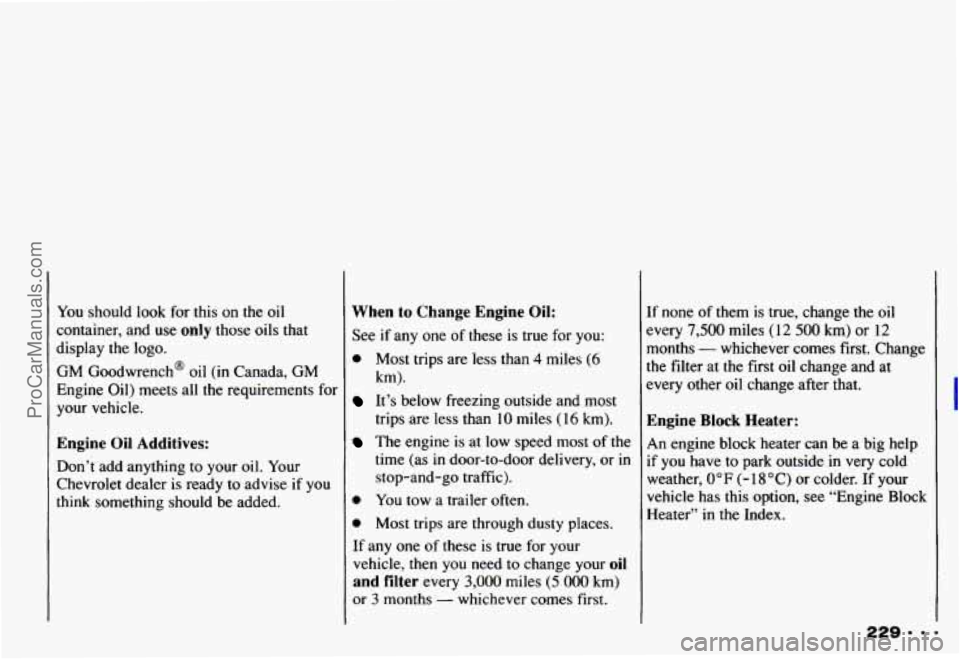
You should look for this on the oil
container, and use
only those oils that
display the logo.
GM Goodwrench@
oil (in Canada, GM
Engine Oil) meets all
the requirements for
your vehicle.
Engine Oil Additives:
Don’t add anything to your oil. Your
Chevrolet dealer is ready
to advise if you
think something should be added.
When to Change Engine Oil:
See if any one of these is true for you:
0 Most trips are less than 4 miles (6
km).
It’s below freezing outside and most
trips are less than
10 miles (16 km).
The engine is at low speed most of the
time (as
in door-to-door delivery, or in
stop-and-go traffic).
0 You tow a trailer often.
0 Most trips are through dusty places.
If any one of these is true for your
vehicle, then you need to change your
oil
and filter every 3,000 miles (5 000 km)
or 3 months - whichever comes first. If none
of them is true, change the oil
every
7,500 miles (12 500 km) or 12
months - whichever comes first. Change
the filter at the first oil change and at
every other
oil change after that.
Engine Block Heater:
An engine block heater can be a big help
if you have to park outside in very cold
weather,
0 OF (- 1 8 O C) or colder. If your
vehicle has this option, see “Engine Block
Heater’’
in the Index.
ProCarManuals.com
Page 243 of 358
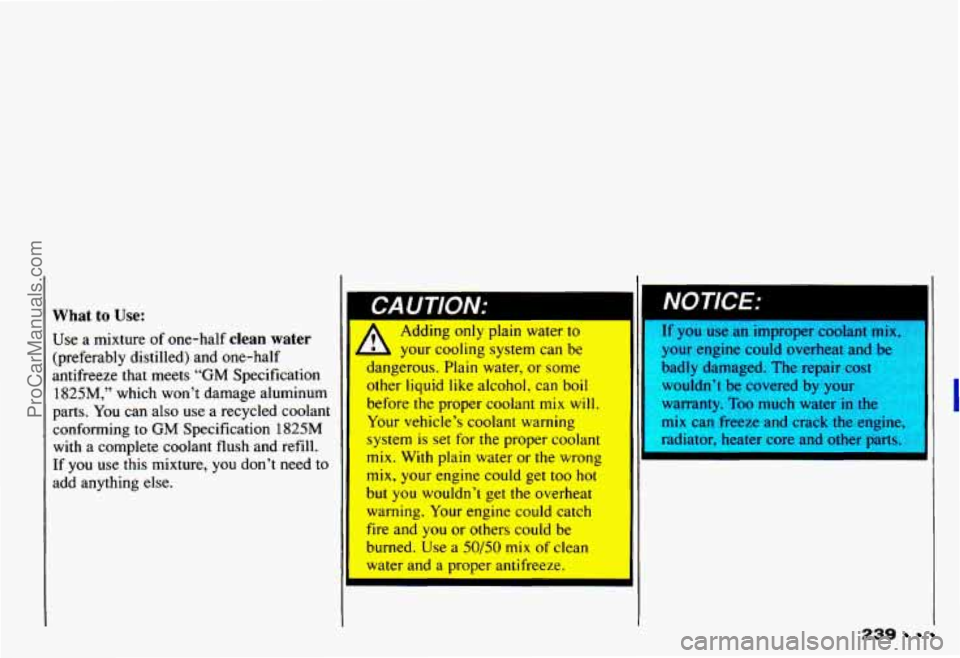
What to Use:
Use a mixture of one-half clean water
(preferably distilled) and one-half
antifreeze that meets
“GM Specification
1825M,” which won’t damage aluminum
parts. You can also use a recycled coolant
conforming to
GM Specification 1825M
with a complete coolant flush and refill.
If you use this mixture, you don’t need to
add anything else.
Adding only plain water to
- b your coding system can be
dangerous. Plain water, or some
other liquid like alcohol, can boil
before the proper coolant mix will.
Your vehicle’s coolant warning
system is set for the proper coolant I
mix. With plain water or the wrong
mix, your engine could get too hot
but you wouldn’t get the overheat
warning. Your
engine could catch
fire and YOU or others could be
burned. Use a 50/50 mix of clean
water and a proper antifreeze.
--
I If you use an improper coolant mix,
your engine could overheat and be
badly damaged. The repair cost
wouldn’t be covered by your
warranty.
Too much water in 1-
mix can freeze and crack the engine,
radiator, heater core and other parts.
239
ProCarManuals.com